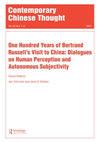The Section Division of the Laozi and its Examination
IF 0.4
3区 哲学
0 ASIAN STUDIES
引用次数: 5
Abstract
EDITOR’S ABSTRACT This article argues that the early Laozi text underwent three stages: The first (in the middle Warring States period) had section divisions on the basis of the meaning. The second stage (from late Warring States period to early Han) was the formative period of the Laozi text influenced by cosmological numerology; the Silk Manuscript version A is its testimony. The third stage (in the mid-Western Han) finalized the text through the canonization of the Classic by Emperor Jing; it is represented by the Peking University Han Bamboo Slips, Yan Zun, and Liu Xiang versions and became the received edition. From the Han Bamboo Slips to the Liu Xiang version, the Laozi’s two parts and section numbering became increasingly balanced and symmetric. Ding urges scholars to pay attention to all these developments when studying the Laozi text.《老子》的科分及其考试
摘要本文认为早期老子文本经历了三个阶段:第一个阶段(战国中期)是根据意义划分的。第二阶段(战国后期至汉初)是受宇宙论命理影响的老子文本形成期;《帛书》甲本就是它的见证。第三阶段(西汉中期)经景帝对《经》的册封,最终确定了文本;以北京大学汉简、颜尊、刘向等版本为代表,成为传世版本。从汉简到刘本,老子的两部、两段编号越来越平衡对称。丁敦促学者们在研究老子文本时注意这些发展。
本文章由计算机程序翻译,如有差异,请以英文原文为准。
求助全文
约1分钟内获得全文
求助全文
来源期刊

CONTEMPORARY CHINESE THOUGHT
Multiple-
CiteScore
0.10
自引率
0.00%
发文量
0
期刊介绍:
This wide ranging journal is essential reading for anyone who wants to understand the diverse themes and influences that shape Chinese thought today. It features translations of the most current and influential Chinese writings on all aspects of philosophical endeavor, from theoretical essays on systems to studies of China"s cultural and religious development, from interpretations of the Chinese classics to exegeses on Marxist thought.
 求助内容:
求助内容: 应助结果提醒方式:
应助结果提醒方式:


